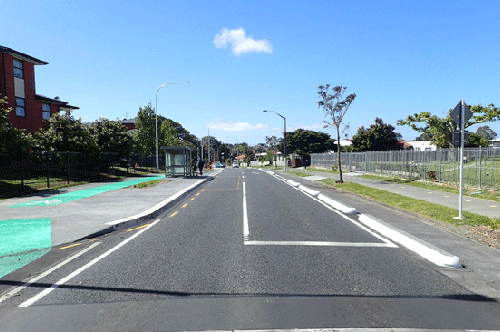Active transport in growing cities
The Future Streets project partners have made changes to streets in Central Māngere, including safer bicycle lanes. Here a bicycle lane flows safely around a bus stop, by temporarily sharing a footpath space. Photo: Mackie Research.
By Dr Hamish Mackie, Mackie Research
In
However, serious effort is needed if we are to reverse the steady decline in walking and cycling for transport in
Ultimately, we may need to consider the design of towns and cities that people actually want to live in by taking much greater notice of residents’ preferences, perceptions, and ideas. When effort is taken to understand the views of people who live in towns and cities, in most cases, preferences for better and more walking and cycling opportunities are highly valued.
The MBIE-funded Future Streets research project is testing alternative street designs that afford user-friendly and safe travel by all travel modes. Led by Mackie Research, and partnering with Auckland Transport, the New Zealand Transport Agency, and the Māngere Otahuhu Local board, the project partners made changes to streets in Central Māngere and a substantial before/after controlled study design is being used to understand the impacts of the changes.
Following the recent implementation of the infrastructure, follow-up data collection is underway over the next two years to monitor the effect of Future Streets (with the associated environmental changes and other community-generated supporting activities to promote physical activity for transport) on the health, safety, travel patterns and social outcomes of Māngere residents.
Dr Hamish Mackie, Mackie Research principal researcher, recently presented his work at the March Speaker’s Science Forum hosted at Parliament’s Grand Hall by Dr Jian Yang Chair of the Science and Education Select Committee. The science forum is a well-attended series of research presentations for Members of Parliament organised by The Royal Society of
Forum subjects later this year include “Production, protection and adding value” with Dr Armin Werner from Lincoln Agritech, “Big Data, Big Value” with Dr Young from MRINZ on using data to drive better medical practice and patient care, and “New Zealand’s space science” with Dr Greg Bodeker from the new Regional Research Institute CSST (Centre for Space Science Technology).
For a copy of Hamish and Jared’s presentation to The Speaker’s Science Forum, please download the PDF. (7MB)
Date posted: 14 March 2017

